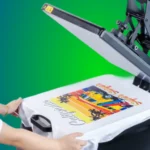How to Press DTF Transfers? Best Tips for Perfect Prints

Direct-to-Film (DTF transfers) leverage a digital print-on-film process combined with adhesive powder to produce vibrant, soft-hand graphics that adhere to nearly any textile. Unlike vinyl cuts or labor-intensive screen printing, DTF requires no screens, no fabric pretreatment, and minimal cleanup—simply print, shake on powder, cure, and apply with your heat press. This streamlined workflow makes DTF ideal for small-batch runs, one-off custom orders, and highly detailed artwork featuring gradients, fine lines, or photographic imagery.
DTF’s versatility shines across fabric types—cotton tees, polyester jerseys, tri-blends, even nylon bags—and it supports full-color prints with excellent wash durability. Because you control each step, from transfer paper selection to heat press settings, you achieve consistent, professional-quality results without long lead times. Brands and decorators favor DTF for its cost efficiency on low volumes, rapid turnaround, and the ability to expand into custom UV DTF transfers or DTF wholesale transfers. By mastering DTF techniques, you unlock limitless creative possibilities and deliver soft, durable, wash-resistant graphics that elevate any apparel line.
What You Need Before Pressing DTF Transfers
Equipment Checklist
- Heat press machine capable of stable temperatures
- Digital printer with DTF inks and custom DTF transfer film
- Adhesive powder and curing station
- Teflon sheet or parchment paper
- Heat resistant tape for alignment
- Lint-free cloths and isopropyl alcohol
Workspace & Safety Tips
Before you press DTF transfers, organize a dedicated, clutter-free workspace with ample lighting and a sturdy table. Position your heat press machine on a level, heat-resistant mat to protect surfaces. Preheat the platen to your target heat press temperature, then wipe it down with isopropyl alcohol and a lint-free cloth to remove any residue that could mar your heat transfer. Secure each DTF transfer in place using heat resistant tape—this ensures precise alignment and prevents slipping under medium pressure. Always wear heat-resistant gloves and safety glasses, and operate in a well-ventilated area to avoid inhaling fumes. Keep a fire extinguisher nearby and never leave the press unattended while hot. By maintaining a clean environment and following these precautions, you ensure consistent results and protect both your equipment and yourself.
Ideal Heat Press Settings for DTF Transfers
Recommended Temperature & Time
For consistent dtf transfers, set your heat press to 160 °C and dwell for 15 seconds—the proven time and temp for DTF transfers. This heat press temperature delivers the optimal temperature needed to fully melt the adhesive powder and lock in vibrant inks without scorching fibers. Use a calibrated heat press machine and verify plate temperature with a craft thermometer. If you notice edges lifting or prints peeling, bump the temperature up by 5 °C or extend the dwell by 2 seconds. Conversely, if you spot fabric discoloration or burnt edges, reduce temperature by 5 °C and shorten the press time by 2 seconds. Always run a quick test swatch to confirm your temperature settings and ensure flawless heat transfer results across your entire production run.
Pressure Settings
Applying the right pressure is as crucial as getting the heat press temperature correct. Aim for firm pressure—approximately 30 psi on a clamshell press or medium pressure on a pneumatic model—to ensure the DTF transfer film bonds evenly across the entire design. Too light, and edges won’t adhere; too heavy, and fine details can blur or the fabric may pucker. Always test pressure on a fabric scrap, adjusting your press’s pressure knob or gauge until you achieve a crisp, solid image. Use heat resistant tape to hold the transfer in place without affecting pressure distribution. Proper pressure paired with accurate temperature and time settings yields professional, durable prints.
Step-by-Step: How to Press a DTF Transfer
- Preheat garment at 160 °C for 5 s to remove moisture.
- Place the DTF transfer film face-down on the fabric.
- Cover with a teflon sheet.
- Press DTF transfers at 160 °C for 15 s using firm pressure.
- Hot peel for a smooth finish or wait to cold peel for textured results.
- Post-press for 5 s to set.
Common Mistakes to Avoid
Transfer not sticking properly?
If your DTF transfer edges lift or peel, increase your heat press temperature by 5 °C or extend the heat press DTF transfers dwell time by 2 seconds. Confirm your temperature range accuracy with a thermometer and verify you’re applying firm pressure to fully melt the adhesive powder.
Also Read – Common UV DTF Transfer Mistakes
Cracking after washing?
Cracks often result from excessive heat or improper peel timing. Verify you’re using the correct hot peel or cold peel technique: hot peel for softer finishes, cold peel for textured looks. If cracking persists, reduce the heat press temperature by 5 °C and extend the dwell by 1–2 seconds. Finish with a quick post-press (5 seconds at reduced heat) to lock in flexibility and prevent future cracks.
Film not peeling cleanly?
Inconsistent peeling often stems from mismatched peel methods and heat press settings. Use a hot peel for thicker transfer paper and adhesive powder layers—remove immediately for a smooth finish. For lightweight films, opt for a cold peel once cooled. Maintain a steady 180° peel angle to avoid lifting edges.
Expert Tips for Perfect DTF Prints Every Time
- Pre-test on scrap fabric.
- Use heat resistant tape to anchor transfers.
- Calibrate your heat press machine weekly.
- Store film in a cool, dry place.
- Rotate adhesive powder to avoid clumping.
Also Read – What Temperature Is Best for DTF Transfers
Final Thoughts
Mastering how to press DTF transfers comes down to dialing in the DTF transfer time and temp, honing your heat press settings, and applying consistent firm pressure. By adhering to our recommended temperature and time settings—160 °C for 15 s with medium pressure—you’ll achieve vibrant, soft-hand prints that resist cracking and washing. Remember to test hot peel versus cold peel to match your design’s texture preferences, and always align films with heat resistant tape for perfect registration. Ready to ramp up production? Discover our dtf wholesale transfers for bulk savings or customize orders with custom DTF transfer services at Southern Style Graphics. With the right workflow and premium materials, you’ll delight customers and elevate your print game to new heights.



